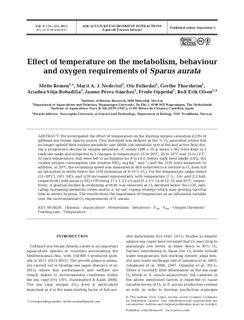Effect of temperature on the metabolism, behaviourand oxygen requirements of Sparus aurata
Remen, Mette; Olsen, Rolf Erik; Oppedal, Frode; Thorsheim, Grethe Beate; Folkedal, Ole; Sitjà-Bobadilla, Ariadna; Pérez-Sánchez, Jaume; Nederlof, Marit A. J.
Journal article, Peer reviewed
Permanent lenke
http://hdl.handle.net/11250/299018Utgivelsesdato
2015-09-03Metadata
Vis full innførselSamlinger
- Articles [3011]
- Publikasjoner fra CRIStin [3061]
Originalversjon
Remen M, Nederlof MAJ, Folkedal O, Thorsheim G and others (2015) Effect of temperature on the metabolism, behaviour and oxygen requirements of Sparus aurata. Aquacult Environ Interact 7:115-123 10.3354/aei00141Sammendrag
We investigated the effect of temperature on the limiting oxygen saturation (LOS) of gilthead sea bream Sparus aurata. This threshold was defined as the % O2 saturation where fish no longer upheld their routine metabolic rate (RMR, the metabolic rate of fed and active fish) during a progressive decline in oxygen saturation. S. aurata (398 ± 10 g, mean ± SE) were kept in 3 replicate tanks and subjected to 3 changes in temperature: 16 to 20°C, 20 to 16°C and 16 to 12°C. At each temperature, fish were left to acclimatize for 8 to 10 d, before daily feed intake (DFI), the routine oxygen consumption rate (routine MO2, mg kg-1 min-1) and the LOS were measured. In addition, at 20°C the swimming speed was measured in fish subjected to a decline in O2 from full air saturation to levels below the LOS (minimum of 8-10% O2). For the temperature range tested (12-20°C), DFI, MO2 and LOS increased exponentially with temperature (7.5-, 3.6- and 2.2-fold, respectively) with mean (± SE) LOS being 17 ± 1, 21 ± 0 and 35 ± 5% O2 at 12, 16 and 20°C, respectively. A gradual decline in swimming activity was observed as O2 declined below the LOS, indicating increasing metabolic stress and/or a ‘sit-out’ coping strategy which may prolong survival time in severe hypoxia. The results show the importance of temperature as an influential variable over the environmental O2 requirements of S. aurata.
Beskrivelse
-

